Babak Rahimi Ardabili
Shopformer: Transformer-Based Framework for Detecting Shoplifting via Human Pose
Apr 28, 2025Abstract:Shoplifting remains a costly issue for the retail sector, but traditional surveillance systems, which are mostly based on human monitoring, are still largely ineffective, with only about 2% of shoplifters being arrested. Existing AI-based approaches rely on pixel-level video analysis which raises privacy concerns, is sensitive to environmental variations, and demands significant computational resources. To address these limitations, we introduce Shopformer, a novel transformer-based model that detects shoplifting by analyzing pose sequences rather than raw video. We propose a custom tokenization strategy that converts pose sequences into compact embeddings for efficient transformer processing. To the best of our knowledge, this is the first pose-sequence-based transformer model for shoplifting detection. Evaluated on real-world pose data, our method outperforms state-of-the-art anomaly detection models, offering a privacy-preserving, and scalable solution for real-time retail surveillance. The code base for this work is available at https://github.com/TeCSAR-UNCC/Shopformer.
PHEVA: A Privacy-preserving Human-centric Video Anomaly Detection Dataset
Aug 26, 2024Abstract:PHEVA, a Privacy-preserving Human-centric Ethical Video Anomaly detection dataset. By removing pixel information and providing only de-identified human annotations, PHEVA safeguards personally identifiable information. The dataset includes seven indoor/outdoor scenes, featuring one novel, context-specific camera, and offers over 5x the pose-annotated frames compared to the largest previous dataset. This study benchmarks state-of-the-art methods on PHEVA using a comprehensive set of metrics, including the 10% Error Rate (10ER), a metric used for anomaly detection for the first time providing insights relevant to real-world deployment. As the first of its kind, PHEVA bridges the gap between conventional training and real-world deployment by introducing continual learning benchmarks, with models outperforming traditional methods in 82.14% of cases. The dataset is publicly available at https://github.com/TeCSAR-UNCC/PHEVA.git.
Expert with Clustering: Hierarchical Online Preference Learning Framework
Jan 26, 2024Abstract:Emerging mobility systems are increasingly capable of recommending options to mobility users, to guide them towards personalized yet sustainable system outcomes. Even more so than the typical recommendation system, it is crucial to minimize regret, because 1) the mobility options directly affect the lives of the users, and 2) the system sustainability relies on sufficient user participation. In this study, we consider accelerating user preference learning by exploiting a low-dimensional latent space that captures the mobility preferences of users. We introduce a hierarchical contextual bandit framework named Expert with Clustering (EWC), which integrates clustering techniques and prediction with expert advice. EWC efficiently utilizes hierarchical user information and incorporates a novel Loss-guided Distance metric. This metric is instrumental in generating more representative cluster centroids. In a recommendation scenario with $N$ users, $T$ rounds per user, and $K$ options, our algorithm achieves a regret bound of $O(N\sqrt{T\log K} + NT)$. This bound consists of two parts: the first term is the regret from the Hedge algorithm, and the second term depends on the average loss from clustering. The algorithm performs with low regret, especially when a latent hierarchical structure exists among users. This regret bound underscores the theoretical and experimental efficacy of EWC, particularly in scenarios that demand rapid learning and adaptation. Experimental results highlight that EWC can substantially reduce regret by 27.57% compared to the LinUCB baseline. Our work offers a data-efficient approach to capturing both individual and collective behaviors, making it highly applicable to contexts with hierarchical structures. We expect the algorithm to be applicable to other settings with layered nuances of user preferences and information.
Integrating AI into CCTV Systems: A Comprehensive Evaluation of Smart Video Surveillance in Community Space
Dec 04, 2023
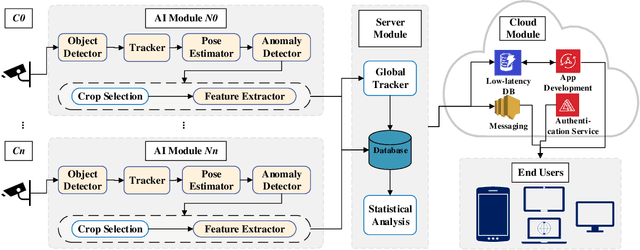
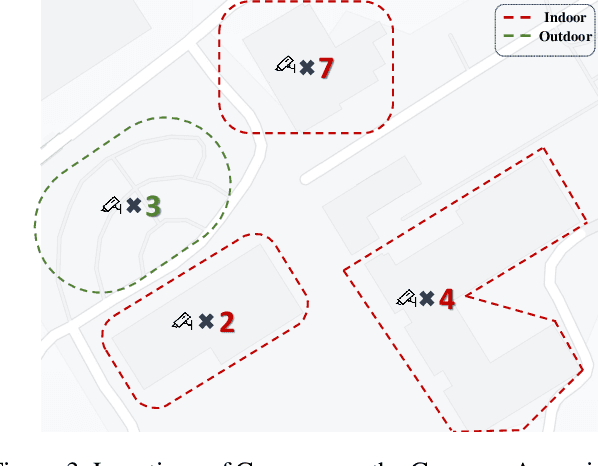
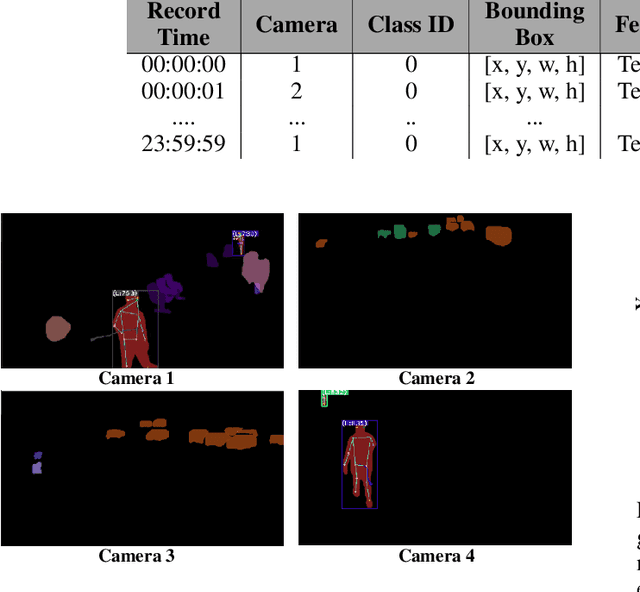
Abstract:This article presents an AI-enabled Smart Video Surveillance (SVS) designed to enhance safety in community spaces such as educational and recreational areas, and small businesses. The proposed system innovatively integrates with existing CCTV and wired camera networks, simplifying its adoption across various community cases to leverage recent AI advancements. Our SVS system, focusing on privacy, uses metadata instead of pixel data for activity recognition, aligning with ethical standards. It features cloud-based infrastructure and a mobile app for real-time, privacy-conscious alerts in communities. This article notably pioneers a comprehensive real-world evaluation of the SVS system, covering AI-driven visual processing, statistical analysis, database management, cloud communication, and user notifications. It's also the first to assess an end-to-end anomaly detection system's performance, vital for identifying potential public safety incidents. For our evaluation, we implemented the system in a community college, serving as an ideal model to exemplify the proposed system's capabilities. Our findings in this setting demonstrate the system's robustness, with throughput, latency, and scalability effectively managing 16 CCTV cameras. The system maintained a consistent 16.5 frames per second (FPS) over a 21-hour operation. The average end-to-end latency for detecting behavioral anomalies and alerting users was 26.76 seconds.
Real-World Community-in-the-Loop Smart Video Surveillance -- A Case Study at a Community College
Mar 22, 2023
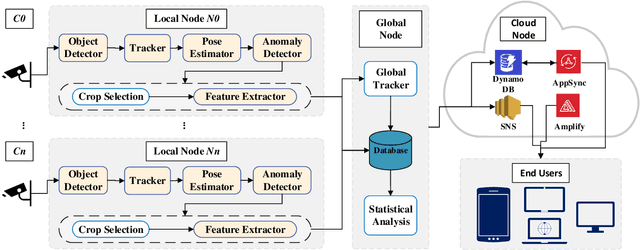

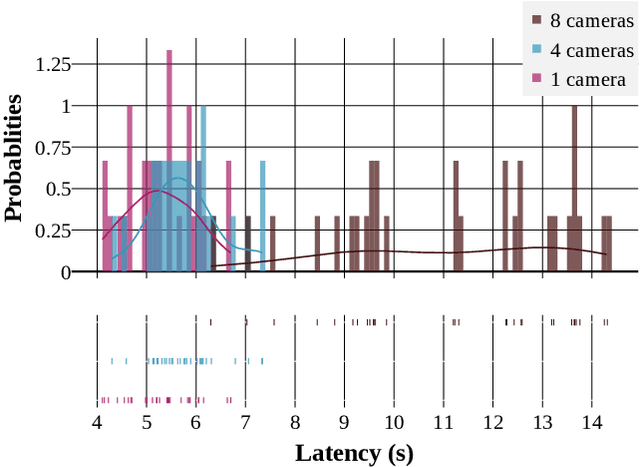
Abstract:Smart Video surveillance systems have become important recently for ensuring public safety and security, especially in smart cities. However, applying real-time artificial intelligence technologies combined with low-latency notification and alarming has made deploying these systems quite challenging. This paper presents a case study for designing and deploying smart video surveillance systems based on a real-world testbed at a community college. We primarily focus on a smart camera-based system that can identify suspicious/abnormal activities and alert the stakeholders and residents immediately. The paper highlights and addresses different algorithmic and system design challenges to guarantee real-time high-accuracy video analytics processing in the testbed. It also presents an example of cloud system infrastructure and a mobile application for real-time notification to keep students, faculty/staff, and responsible security personnel in the loop. At the same time, it covers the design decision to maintain communities' privacy and ethical requirements as well as hardware configuration and setups. We evaluate the system's performance using throughput and end-to-end latency. The experiment results show that, on average, our system's end-to-end latency to notify the end users in case of detecting suspicious objects is 5.3, 5.78, and 11.11 seconds when running 1, 4, and 8 cameras, respectively. On the other hand, in case of detecting anomalous behaviors, the system could notify the end users with 7.3, 7.63, and 20.78 seconds average latency. These results demonstrate that the system effectively detects and notifies abnormal behaviors and suspicious objects to the end users within a reasonable period. The system can run eight cameras simultaneously at a 32.41 Frame Per Second (FPS) rate.
Understanding Policy and Technical Aspects of AI-Enabled Smart Video Surveillance to Address Public Safety
Feb 08, 2023Abstract:Recent advancements in artificial intelligence (AI) have seen the emergence of smart video surveillance (SVS) in many practical applications, particularly for building safer and more secure communities in our urban environments. Cognitive tasks, such as identifying objects, recognizing actions, and detecting anomalous behaviors, can produce data capable of providing valuable insights to the community through statistical and analytical tools. However, artificially intelligent surveillance systems design requires special considerations for ethical challenges and concerns. The use and storage of personally identifiable information (PII) commonly pose an increased risk to personal privacy. To address these issues, this paper identifies the privacy concerns and requirements needed to address when designing AI-enabled smart video surveillance. Further, we propose the first end-to-end AI-enabled privacy-preserving smart video surveillance system that holistically combines computer vision analytics, statistical data analytics, cloud-native services, and end-user applications. Finally, we propose quantitative and qualitative metrics to evaluate intelligent video surveillance systems. The system shows the 17.8 frame-per-second (FPS) processing in extreme video scenes. However, considering privacy in designing such a system results in preferring the pose-based algorithm to the pixel-based one. This choice resulted in dropping accuracy in both action and anomaly detection tasks. The results drop from 97.48 to 73.72 in anomaly detection and 96 to 83.07 in the action detection task. On average, the latency of the end-to-end system is 36.1 seconds.
Ancilia: Scalable Intelligent Video Surveillance for the Artificial Intelligence of Things
Jan 09, 2023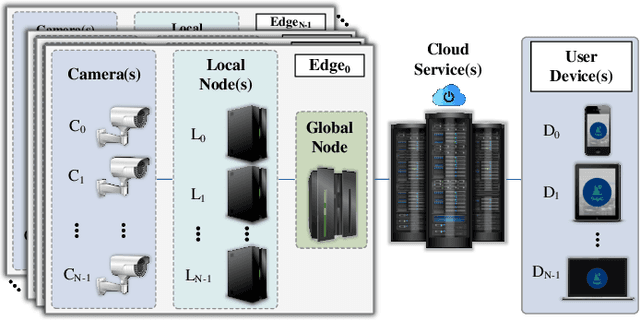
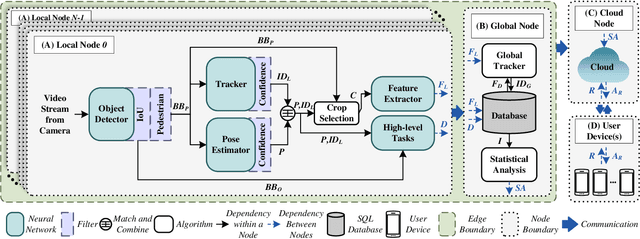
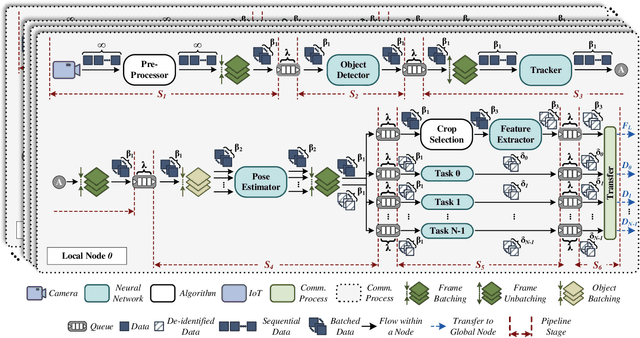

Abstract:With the advancement of vision-based artificial intelligence, the proliferation of the Internet of Things connected cameras, and the increasing societal need for rapid and equitable security, the demand for accurate real-time intelligent surveillance has never been higher. This article presents Ancilia, an end-to-end scalable, intelligent video surveillance system for the Artificial Intelligence of Things. Ancilia brings state-of-the-art artificial intelligence to real-world surveillance applications while respecting ethical concerns and performing high-level cognitive tasks in real-time. Ancilia aims to revolutionize the surveillance landscape, to bring more effective, intelligent, and equitable security to the field, resulting in safer and more secure communities without requiring people to compromise their right to privacy.
Understanding Ethics, Privacy, and Regulations in Smart Video Surveillance for Public Safety
Dec 25, 2022

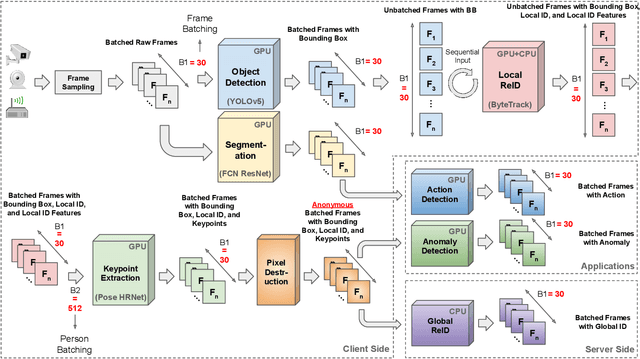
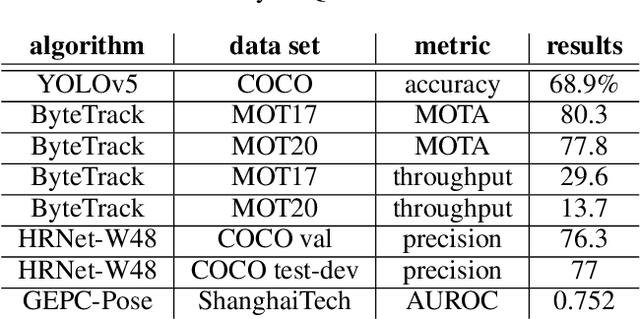
Abstract:Recently, Smart Video Surveillance (SVS) systems have been receiving more attention among scholars and developers as a substitute for the current passive surveillance systems. These systems are used to make the policing and monitoring systems more efficient and improve public safety. However, the nature of these systems in monitoring the public's daily activities brings different ethical challenges. There are different approaches for addressing privacy issues in implementing the SVS. In this paper, we are focusing on the role of design considering ethical and privacy challenges in SVS. Reviewing four policy protection regulations that generate an overview of best practices for privacy protection, we argue that ethical and privacy concerns could be addressed through four lenses: algorithm, system, model, and data. As an case study, we describe our proposed system and illustrate how our system can create a baseline for designing a privacy perseverance system to deliver safety to society. We used several Artificial Intelligence algorithms, such as object detection, single and multi camera re-identification, action recognition, and anomaly detection, to provide a basic functional system. We also use cloud-native services to implement a smartphone application in order to deliver the outputs to the end users.
CHAD: Charlotte Anomaly Dataset
Dec 19, 2022Abstract:In recent years, we have seen a significant interest in data-driven deep learning approaches for video anomaly detection, where an algorithm must determine if specific frames of a video contain abnormal behaviors. However, video anomaly detection is particularly context-specific, and the availability of representative datasets heavily limits real-world accuracy. Additionally, the metrics currently reported by most state-of-the-art methods often do not reflect how well the model will perform in real-world scenarios. In this article, we present the Charlotte Anomaly Dataset (CHAD). CHAD is a high-resolution, multi-camera anomaly dataset in a commercial parking lot setting. In addition to frame-level anomaly labels, CHAD is the first anomaly dataset to include bounding box, identity, and pose annotations for each actor. This is especially beneficial for skeleton-based anomaly detection, which is useful for its lower computational demand in real-world settings. CHAD is also the first anomaly dataset to contain multiple views of the same scene. With four camera views and over 1.15 million frames, CHAD is the largest fully annotated anomaly detection dataset including person annotations, collected from continuous video streams from stationary cameras for smart video surveillance applications. To demonstrate the efficacy of CHAD for training and evaluation, we benchmark two state-of-the-art skeleton-based anomaly detection algorithms on CHAD and provide comprehensive analysis, including both quantitative results and qualitative examination.
 Add to Chrome
Add to Chrome Add to Firefox
Add to Firefox Add to Edge
Add to Edge